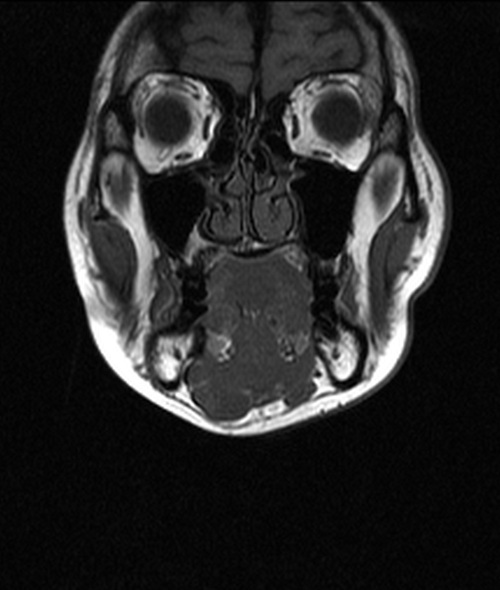Answer of November 2012
Clinical History:
A 34 year old lady with good past health complained of right submental swelling for 4 months. The lesion was non tender and soft on palpation. It did not move when swallowing or protruding tongue. Rest of the oral cavity was clear. MRI was performed for the lesion.
Figure 1. T2 TSE axial MRI Figure 2. T2 TSE axial MRI image
image with fat suppression with fat suppression of the floor
of the floor of mouth of mouth (cranial to Figure 1)
Figure 3. T1 SE Coronal MRI Figure 4. T1 SE Coronal MRI
image of the floor of mouth image with fat suppression and
gadolinium contrast of the floor of
mouth (Same level to Figure 3)
Figure 5. T1 SE Coronal MRI Figure 6. T1 SE Coronal MRI
image of the floor of mouth image with fat suppression and
(posterior to Figure 3) gadolinium contrast of the floor of
mouth (Same level to Figure 4)
Diagnosis:
Diving (Plunging) Ranula
Discussion:
Ranula is mucus retention cyst arising from an obstructed sublingual or minor salivary gland in the sublingual space. It usually presents as a painless swelling during middle age. The lesion can be divided into simple or diving types, with simple ranula confined to the sublingual space and diving type herniating around or through mylohyoid muscle. Actually, diving ranula is believed to result from rupture of simple ranula. When simple ranula is left untreated, it will continue to grow and become ruptured, dissecting down between facial planes into the neck either posterior to the mylohyoid muscle or through a defect or vascular cleft in the mylohyoid muscle.
The ranula in our patient demonstrated the typical T1 hypointense and T2 hyperintense signal with thin rim enhancement. The coronal T1 post contrast images with fat saturation revealed involvement of right sublingual space and anterior aspect of right submandibular space. (Figures 4 and 6) It suggested that the lesion in right sublingual space herniated through the mylohyoid vascular cleft or defect into the anterior aspect of right submandibular space, which is a less common route. For most ranula, the lesion herniated directly posterior to the mylohyoid muscle into the submandibular space.
Contrast-enhanced CT or MR images provide important information not only for diagnosis of the disease but also differentiation of ranula from other differenitial diagnoses, e.g. epidermoid cyst, dermoid cyst, brachial cleft cyst. Imaging is also important in guiding surgery. Surgical excision of the lesion is the treatment of choice, although some authors may believe excision of psuedocyst is unnecessary. If the lesion is planned to be excised, detailed mapping of the lesion provided by imaging can assist the surgeon in planning the approach of resection. Complete resection of the lesion is necessary to prevent recurrence of the lesion.





